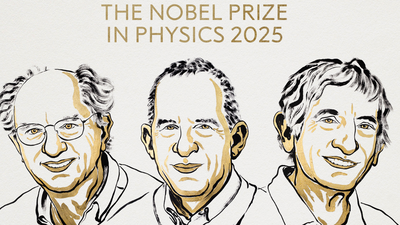The 2025 Nobel Prize in Physics has been awarded to John Clarke of the University of California, Berkeley, Michel H. Devoret of Yale University and the University of California, Santa Barbara, and John M. Martinis of the University of California, Santa Barbara, for their groundbreaking “discovery of macroscopic quantum mechanical tunnelling and energy quantisation in an electric circuit.”The Royal Swedish Academy of Sciences said that their experiments “revealed quantum physics in action” using a chip-based electrical circuit, demonstrating that quantum phenomena can manifest on a scale large enough to be held in the hand.“A major question in physics is the maximum size of a system that can demonstrate quantum mechanical effects,” the Academy said. The laureates’ experiments proved that such effects are not limited to the atomic or subatomic level.In a series of experiments conducted in 1984 and 1985, Clarke, Devoret, and Martinis built an electronic circuit made of superconductors separated by a thin non-conductive layer, a setup known as a Josephson junction. Their measurements showed that when current passed through the circuit, it behaved as though all the charged particles were a single particle filling the entire system.
Nobel week continues
Following the Physics announcement, the Chemistry Nobel will be revealed on Wednesday, followed by Literature on Thursday and the Nobel Peace Prize the most closely watched on Friday. The Nobel Memorial Prize in Economic Sciences will round off the season on October 13.Yesterday, Mary E. Brunkow, Fred Ramsdell, and Dr Shimon Sakaguchi received the Nobel Prize in Medicine for explaining how the immune system distinguishes between harmful invaders and the body’s own cells.In 2024, artificial intelligence pioneers John Hopfield and Geoffrey Hinton were recognised for developing the foundations of machine learning, a discovery that reshaped modern computing. Winners will receive a gold medal, diploma, and 11 million Swedish kronor (around $1 million), presented by King Carl XVI Gustaf at a formal ceremony in Stockholm on 10 December the anniversary of Alfred Nobel’s death in 1896.
How nominations are filed and winners chosen
The process of selecting Nobel laureates in Physics is confidential and by invitation only. Each September, the Nobel Committee for Physics sends out nomination forms to thousands of qualified individuals, including members of the Royal Swedish Academy of Sciences, previous Nobel laureates, and senior university professors worldwide. Self-nominations are not permitted.Completed nominations must reach the committee by January 31. Between March and May, the committee consults external experts to assess the scientific merit of each candidate’s work. After thorough review, a detailed report is compiled and submitted to the Academy in September. The final selection takes place in early October through a majority vote.Under the statutes of the Nobel Foundation, all nomination details including names of candidates and nominators remain sealed for 50 years.
Key facts about the Physics Nobel
Since its inception in 1901, 118 Nobel Prizes in Physics have been awarded, with 47 going to a single laureate and 38 shared among three. The award was not given in six years, largely due to the world wars. So far, 226 individuals have been honoured, including iconic figures like Albert Einstein, Marie Curie, Niels Bohr, Richard Feynman, and Peter Higgs scientists whose discoveries transformed how humanity understands the universe.

